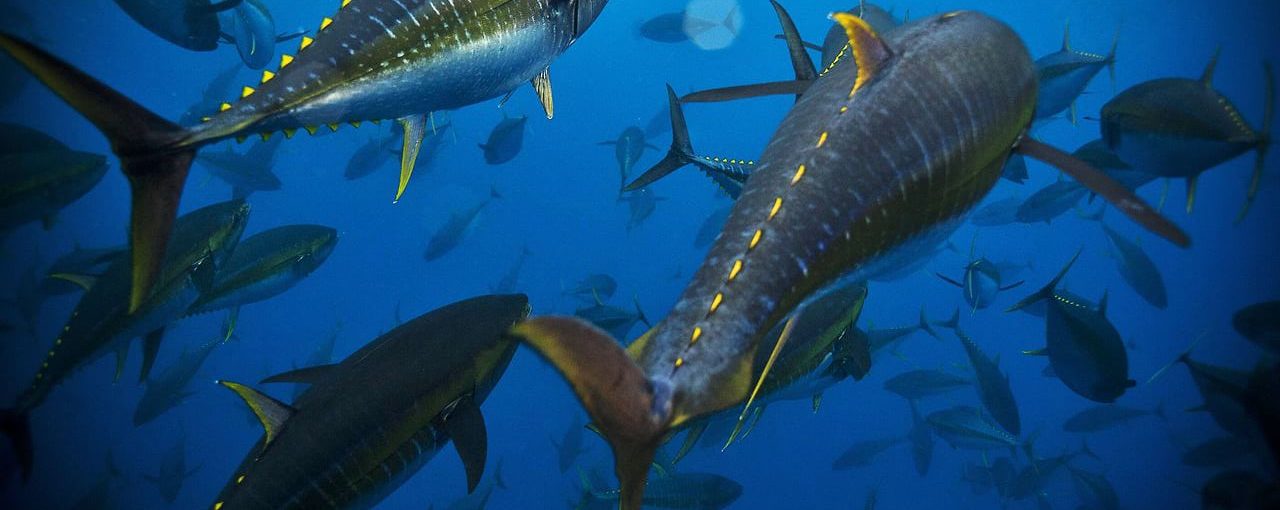Costa Rica Fish Species
Meet the Yellowfin Tuna
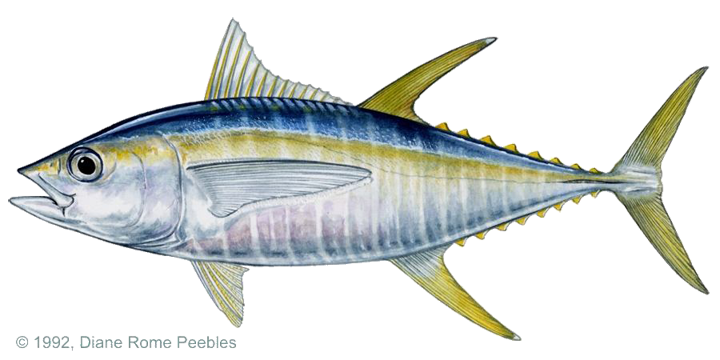
One of FECOP’s primary initiatives is to reduce “bycatch” resulting (most often times) from illegal, non-sustainable, tuna fishing operations in Costa Rica’s Pacific ocean. The aftermath of this illegal activity includes the death of non-targeted species such as sailfish, marlin (billfish), dolphins, sea-turtles, and the destruction fragile marine ecosystems. Learn more about our current initiatives Tuna for Ticos, and The Costa Rica Tuna Decree
From the IGFA Fish Database
Occurs worldwide in deep, warm temperate oceanic waters. It is both pelagic and seasonally migratory, but has been known to come fairly close to shore.
Tuna Fast Facts
Did you know – The yellowfin can be distinguished from the blackfin by the black margins on its finlets?
Tuna are considered warm blooded because they can regulate their own body temperature . The very few partly or fully warm-blooded fish possess organs near their muscles called retia mirabilia that consist of a series of minute parallel veins and arteries that supply and drain the muscles.
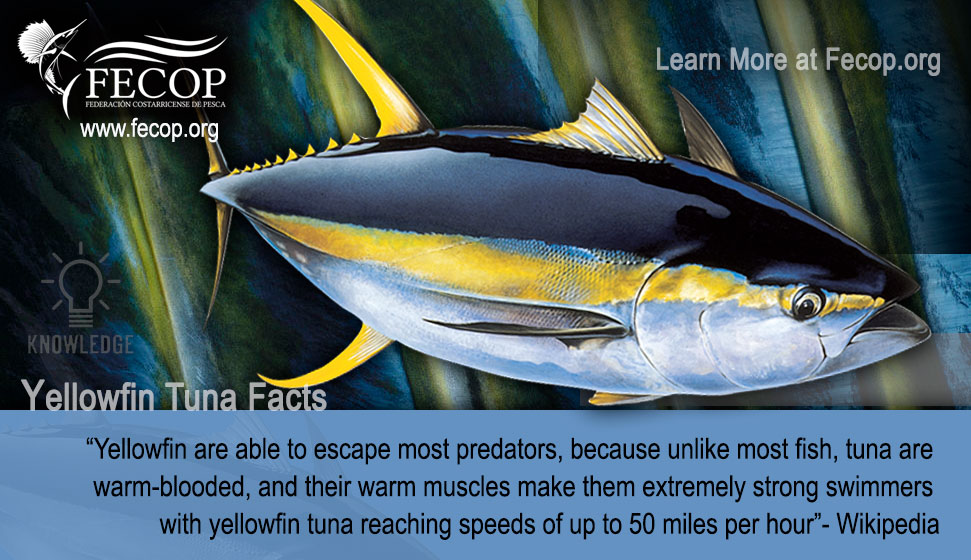
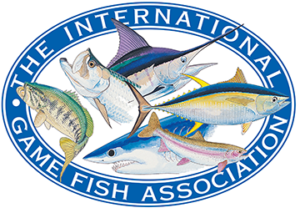 Most large yellowfins have overextended second dorsal and anal fins that may reach more than halfway back to the tail base in some large specimens. In smaller specimens under about 60 lb (27 kg) and in some very large specimens as well, this may not be an accurate distinguishing factor since the fins do not appear to be as long in all specimens. The pectoral fins in adults reach to the origin of the second dorsal fin, but never beyond the second dorsal fin to the finlets as in the albacore. The bigeye tuna (T. obesus) and the blackfin tuna (T. atlanticus) may have pectoral fins similar in length to those of the yellowfin. The yellowfin can be distinguished from the blackfin by the black margins on its finlets. Blackfin tuna, like albacore, have white margins on the finlets. It can be distinguished from the bigeye tuna by the lack of striations on the ventral surface of the liver.
Most large yellowfins have overextended second dorsal and anal fins that may reach more than halfway back to the tail base in some large specimens. In smaller specimens under about 60 lb (27 kg) and in some very large specimens as well, this may not be an accurate distinguishing factor since the fins do not appear to be as long in all specimens. The pectoral fins in adults reach to the origin of the second dorsal fin, but never beyond the second dorsal fin to the finlets as in the albacore. The bigeye tuna (T. obesus) and the blackfin tuna (T. atlanticus) may have pectoral fins similar in length to those of the yellowfin. The yellowfin can be distinguished from the blackfin by the black margins on its finlets. Blackfin tuna, like albacore, have white margins on the finlets. It can be distinguished from the bigeye tuna by the lack of striations on the ventral surface of the liver.
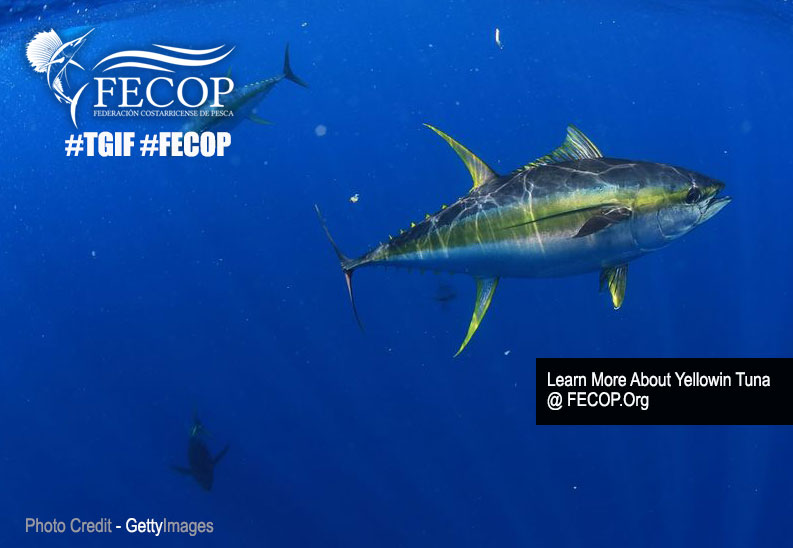
This is probably the most colorful of all the tunas. The back is blue black, fading to silver on the lower flanks and belly. A golden yellow or iridescent blue stripe runs from the eye to the tail, though this is not always prominent. All the fins and finlets are golden yellow though in some very large specimens the elongated dorsal and anal fins may be silver edged with yellow. The finlets have black edges. The belly frequently shows as many as 20 vertical rows of whitish spots.

The diet depends largely on local abundance, and includes flying fish, other small fish, squid and crustaceans. Fishing methods include trolling with small fish, squid, or other trolled baits including strip baits and artificial lures as well as chumming with live bait fishing.
It is highly esteemed both as a sport fish and as table fare. Its flesh is very light compared to that of other tunas, with the exception of the albacore, which has white meat.
If you would like to make an impact and help FECOP stop illegal fishing in Costa Rica, please sign the petition below
Dear representatives,
Presidency of the Republic,
Legislative Assembly Ministry of Agriculture and Livestock,
National Institute of Fisheries and Aquaculture,
Ministry of Environment and Energy,
Vice Ministry of Water and Seas,
National Coast Guard Service,
The situation of illegal fishing that is happening in our country is a serious problem that affects our marine resources, the national economy and that of our communities.
It is for this reason that through this petition we request better controls and effective surveillance for foreign tuna fleets.
Better penalization mechanisms for those who break the law of our country and exploit our resources indiscriminately.
As well as support and prioritization for national fleets in the consolidation of sustainable tuna fishing in our territorial waters.
I hereby support this cause by registering my information on the following petition.
Learn More About FECOPS Battle to Protect Tuna from Illegal Fishing
[post-carousel-pro id=”5785″]
More Costa Rica Fishing Species
Related Posts
Sustainable Fishing – Greensticking for Tuna in Costa Rica
Explaining the Costa Rica Tuna Decree
Tuna for Ticos – Sign the Petition Against Illegal Fishing in Costa Rica
[vc_basic_grid post_type=”post” max_items=”10″ item=”mediaGrid_SimpleOverlay” grid_id=”vc_gid:1540674125261-c03d2600-6f2b-0″ taxonomies=”120″]

